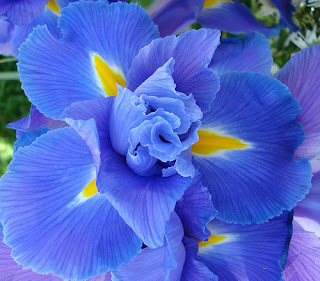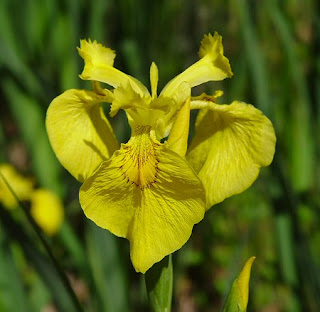Type of Flowers
Iris:
Iris is a genus of 260–300 species of flowering plants with showy flowers,(This Flower Meaning Faith , Thank You For Your Friendship). It takes its name from the Greek word for a rainbow, referring to the wide variety of flower colors found among the many species.As well as being the scientific name, iris is also very widely used as a common name for all Iris species, though some plants called thus belong to other closely related genera. A common name for some species is 'flags', while the plants of the subgenus Scorpiris are widely known as 'junos', particularly in horticulture. It is a popular garden flower.
The often-segregated, monotypic genera Belamcanda (blackberry lily), Hermodactylus (snake's head iris), and Pardanthopsis (vesper iris) are currently included in Iris.
The inflorescences are fan-shaped and contain one or more symmetrical six-lobed flowers. These grow on a pedicel or lack a footstalk. The three sepals, which are spreading or droop downwards, are referred to as "falls". They expand from their narrow base, which in some of the rhizomatous irises has a "beard" (a tuft of short upright extensions growing in its midline), into a broader expanded portion ("limb"), often adorned with veining, lines or dots. The three, sometimes reduced, petals stand upright, partly behind the sepal bases. They are called "standards". Some smaller iris species have all six lobes pointing straight outwards, but generally limb and standards differ markedly in appearance. They are united at their base into a floral tube that lies above the ovary (known as an epigynous or inferior ovary). The styles divide towards the apex into petaloid branches; this is significant in pollination.
The iris flower is of interest as an example of the relation between flowering plants and pollinating insects. The shape of the flower and the position of the pollen-receiving and stigmatic surfaces on the outer petals form a landing-stage for a flying insect, which in probing for nectar, will first come into contact with the perianth, then with the stigmatic stamens in one whorled surface which is borne on an ovary formed of three carpels. The shelf-like transverse projection on the inner whorled underside of the stamens is beneath the overarching style arm below the stigma, so that the insect comes in contact with its pollen-covered surface only after passing the stigma; in backing out of the flower it will come in contact only with the non-receptive lower face of the stigma. Thus, an insect bearing pollen from one flower will, in entering a second, deposit the pollen on the stigma; in backing out of a flower, the pollen which it bears will not be rubbed off on the stigma of the same flower.
The iris fruit is a capsule which opens up in three parts to reveal the numerous seeds within. In some species, these bear an aril.
























No comments:
Post a Comment